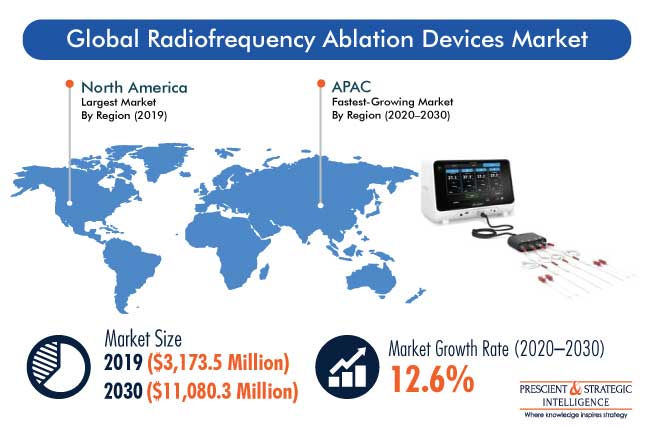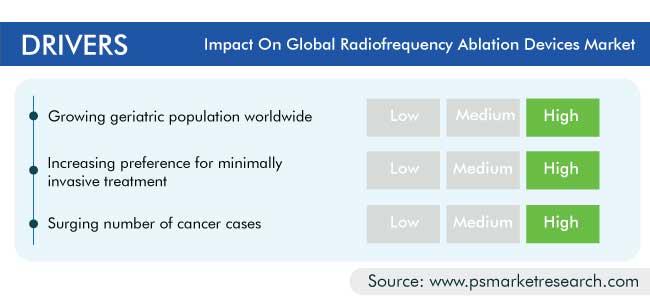Report Code: 12113 | Available Format: PDF | Pages: 154
Radiofrequency Ablation Devices Market Research Report: By Component (Catheter Systems, Generators, Accessories), Application (Oncology, Cardiology, Pain Management), End User (Hospitals, Ambulatory Surgical Centers) - Global Industry Analysis and Demand Forecast to 2030
- Report Code: 12113
- Available Format: PDF
- Pages: 154
- Report Description
- Table of Contents
- Market Segmentation
- Request Free Sample
Market Outlook
The radiofrequency (RF) ablation devices market revenue stood at $3,173.5 million in 2019, and it is expected to advance at a 12.6% CAGR during 2020–2030. The strongest growth drivers for this market include the booming geriatric population, surging healthcare expenditure, rising prevalence of chronic diseases, and technological advancements.
However, the ongoing coronavirus pandemic has had a negative impact on the market due to the sudden shift in the focus toward COVID-19 treatment. As a result, this pandemic has resulted in a delay and suspension of the treatments of several other diseases.

Catheter Systems To Observe Fastest Growth
The catheter systems category, under the component segment, is expected to register the fastest growth in the market for RF ablation devices in the coming years. These systems comprise electrodes, probes, and catheters that are inserted into the affected body parts for ablation procedures. This market growth can be owed to the surging prevalence of chronic diseases resulting in a large number of RF ablation treatments.
Hospitals Highest-Revenue-Generating Category
The hospital category, within the end user segment, accounted for the largest share in 2019 due to the wide adoption of RF ablation systems at hospitals. These healthcare settings are preferred choice of people for the diagnosis and treatment of diseases because they offer the best-possible service.
Pain Management To Register Fastest Growth
The pain management category, under segmentation by application, is expected to demonstrate the fastest RF ablation devices market growth in the future. This will be due to the increasing incidence of chronic pain and burgeoning demand for minimally invasive procedures being witnessed by healthcare facilities. The cost-effectiveness and soaring awareness about RF ablation treatments for pain relief will also contribute to the growth of this category worldwide.
North America To Emerge as Largest Market
North America generated the highest revenue in 2019, and it is expected to continue its dominance between 2020 and 2030. The RF ablation devices industry in this region is dominated by the U.S. due to the presence of a wide installation base for such devices in the country. Besides, the presence of research institutes and private healthcare providers that are increasingly using RF ablation equipment will boost the market growth in the region.
Asia-Pacific (APAC) Market Driven by Vast Aging Population
The APAC region is expected to record the fastest growth due to the presence of a large population of the elderly, who are more susceptible to chronic diseases. For example, the World Population Ageing 2019 report states that there were 395.3 million people aged 65 years or above in Asia in 2019, and the number is expected to reach 954.7 million by 2050. Thus, the growing population of the elderly will propel the prevalence of numerous chronic diseases, which will further drive the RF ablation devices market, by amplifying the requirement for minimally invasive procedures. Moreover, the heavy investments by the leading companies in the developing nations of APAC are expected to drive the adoption of RF ablation procedures in the region.
Acquisitions Are Key Market Trend
Key market players are focusing on acquiring others to increase their market share and expand their presence around the world. For example, in January 2019, Medtronic Plc announced its plan to acquire Epix Therapeutics Inc., a private medical device company, which creates catheter-based temperature-controlled cardiac ablation devices. Through this acquisition, the former widened its ablation device portfolio, and it is now providing advanced tools to physicians to treat cardiac arrhythmias.

Rising Inclination toward Minimally Invasive Treatments Leading to Market Expansion
Patients are increasingly opting for minimally invasive treatments for several diseases, as this approach causes less pain and scarring and minimizes the chances of infections related to open surgeries. For example, an individual with back pain, who is not getting relief from physiotherapy or medication, can undergo RF ablation to remove the nerve fibers in the spinal cord, so the pain signals do not reach the brain. Hence, the lower risk of complications offered by this treatment mode has supported the adoption of RF ablation equipment globally.
Surging Global Geriatric Population Propelling Market Growth
Another key driver for the RF ablation devices market is the soaring elderly population, as it is highly prone to disorders and abnormalities. Owing to their weak immune system, older people require minimally invasive treatments for several chronic diseases, such as cancer and cardiovascular diseases (CVDs). According to the UN World Population Ageing 2019 report, the population of individuals aged 65 years or above was 703 million in 2019, and it is estimated to reach 1.5 billion by 2050.
| Report Attribute | Details |
Historical Years |
2014-2019 |
Forecast Years |
2020-2030 |
Base Year (2019) Market Size |
$3,173.5 Million |
Forecast Period CAGR |
12.6% |
Report Coverage |
Market Trends, Revenue Estimation and Forecast, Segmentation Analysis, Impact of COVID-19, Regional and Country Breakdown, Competitive Analysis, Companies’ Strategic Developments, Company Profiling |
Market Size by Segments |
Component, Application, End User, Region |
Market Size of Geographies |
U.S., Canada, Germany, U.K., France, Italy, Spain, China, Japan, India, Australia, Brazil, Mexico, Argentina, South Africa, Saudi Arabia, U.A.E. |
Secondary Sources and References (Partial List) |
American Medical Association, German Cancer Research Center, International Agency for Research on Cancer, International Atomic Energy Agency, International Medical Device Regulators Forum, United States Food and Drug Administration, U.S. Census Bureau, World Health Organization |
Explore more about this report - Request free sample
Market Players Are Introducing New Products to Gain Competitive Edge
The global radiofrequency ablation devices market has players such as Medtronic Plc, Johnson & Johnson, Abbott Laboratories, Smith & Nephew Plc, Boston Scientific Corporation, Avanos Medical Inc., RF Medical Co. Ltd., AngioDynamics Inc., AtriCure Inc., and Stryker Corporation.
In recent years, players in the radiofrequency ablation devices industry have pursued product approvals and mergers & acquisitions in order to stay ahead of their competitors. For instance:
- In November 2020, Abbott Laboratories launched IonicRF Generator, an RF ablation device designed to target specific nerves and prevent pain signals from making it to the brain. This device received the approval of the U.S. Food and Drug Administration (USFDA) in October 2020 for the U.S. market.
- In August 2020, Hologic Inc. announced to acquire Acessa Health Inc., which commercializes the Acessa ProVu system that integrates RF ablation with advanced intra-abdominal ultrasound visualization and guidance mapping. The objective of this acquisition is to increase the RFA product portfolios of Hologic.
Key Players in Radiofrequency Ablation Devices Market Include:
-
Johnson & Johnson
-
Smith & Nephew Plc
-
Abbott Laboratories
-
Stryker Corporation
-
Medtronic Plc
-
Boston Scientific Corporation
-
Baylis Medical Company Inc.
-
Avanos Medical Inc.
-
AngioDynamics Inc.
-
RF Medical Co. Ltd.
-
AtriCure Inc.
-
MedSphere International Inc.
-
Diros Technology Inc.
Market Size Breakdown by Segment
The global radiofrequency (RF) ablation devices market report offers comprehensive market segmentation analysis along with market estimation for the period 2014–2030.
Based on Component
- Catheter Systems
- Generators
- Accessories
Based on Application
- Oncology
- Cardiology
- Pain Management
Based on End User
- Hospitals
- Ambulatory Surgical Centers (ASCs)
Geographical Analysis
- North America
- U.S.
- Canada
- Europe
- Germany
- France
- U.K.
- Italy
- Spain
- Asia-Pacific (APAC)
- China
- Japan
- India
- Australia
- Latin America (LATAM)
- Brazil
- Mexico
- Argentina
- Middle East and Africa (MEA)
- South Africa
- Saudi Arabia
- U.A.E
The radiofrequency ablation devices market will reach $11,080.3 million by 2030.
Hospitals generate the highest revenue in the radiofrequency ablation devices industry.
Asia-Pacific offers the best opportunities for radiofrequency ablation devices market investors.
The key radiofrequency ablation devices industry growth drivers are the rising preference for minimally invasive procedures, booming geriatric population, and increasing prevalence of cancer.
The radiofrequency ablation devices market competitive landscape is characterized by product launches.
Want a report tailored exactly to your business strategy?
Request CustomizationWant an insight-rich discussion with the report author?
Speak to AnalystOur dedication to providing the most-accurate market information has earned us verification by Dun & Bradstreet (D&B). We strive for quality checking of the highest level to enable data-driven decision making for you
Our insights into the minutest levels of the markets, including the latest trends and competitive landscape, give you all the answers you need to take your business to new heights
With 24/7 research support, we ensure that the wheels of your business never stop turning. Don’t let time stand in your way. Get all your queries answered with a simple phone call or email, as and when required
We take a cautious approach to protecting your personal and confidential information. Trust is the strongest bond that connects us and our clients, and trust we build by complying with all international and domestic data protection and privacy laws